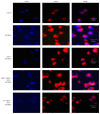Resveratrol Attenuates Microglial Activation via SIRT1-SOCS1 Pathway
- PMID: 28781601
- PMCID: PMC5525071
- DOI: 10.1155/2017/8791832
Resveratrol Attenuates Microglial Activation via SIRT1-SOCS1 Pathway
Abstract
Microglial activation is involved in a variety of neurological disorders, and overactivated microglial cells can secrete large amount of proinflammatory factors and induce neuron death. Therefore, reducing microglial activation is believed to be useful in treating the disorders. In this study, we used 10 ng/ml lipopolysaccharide plus 10 U/ml interferon γ (LPS/IFNγ) to induce N9 microglial activation and explored resveratrol- (RSV-) induced effects on microglial activation and the underlying mechanism. We found that LPS/IFNγ exposure for 24 h increased inducible nitric oxide synthase (iNOS) and nuclear factor κB (NF-κB) p65 subunit expressions in the cells and enhanced tumor necrosis factor α (TNF-α) and interleukin 1β (IL-1β) releases from the cells. RSV of 25 μM reduced the iNOS and NF-κB p65 subunit expressions and the proinflammatory factors' releases; the knockdown of silent information regulator factor 2-related enzyme 1 (SIRT1) or suppressor of cytokine signaling 1 (SOCS1) by using the small interfering RNA, however, significantly abolished the RSV-induced effects on iNOS and NF-κB p65 subunit expressions and the proinflammatory factors' releases. These findings showed that microglial SIRT1-SOCS1 pathway may mediate the RSV-induced inhibition of microglial activation in the LPS/IFNγ-treated N9 microglia.
Figures






References
-
- Ding K., Wang H., Xu J., Lu X., Zhang L., Zhu L. Melatonin reduced microglial activation and alleviated neuroinflammation induced neuron degeneration in experimental traumatic brain injury: possible involvement of mTOR pathway. Neurochemistry International. 2014;76:23–31. doi: 10.1016/j.neuint.2014.06.015. - DOI - PubMed
LinkOut - more resources
Full Text Sources
Other Literature Sources

